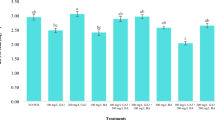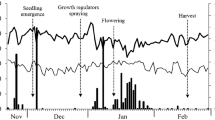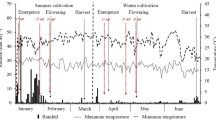Abstract
Field-grown soybean plants (Glycine max (L.) Merr. cv. Evans) were treated with gibberellic acid (GA3; 10gl−1) and/or (2-chloroethyl)-trimethylammonium chloride (CCC; 0.8gl−1) in 1983 and 1984, and subsequent anthesis, pod set, seed size, seed number, and seed yield were determined at one node. The treatments were applied to five leaves in the center of each plant (typically leaves 7–11) and reproductive development at the node in the center of those leaves was monitored. Gibberellin A3 applied “Early” (about 3d before anthesis of the first flower at the monitored node) had no effect on the number of flowers produced, but decreased the fraction of flowers that set pods in both experimental years (by 32% in 1983 and 76% in 1984). Seed size was slightly decreased by the GA3 treatment in 1983 but not in 1984. The “Middle” GA3 treatment (applied about 3 days after the “Early” treatment) slightly decreased the number of pods set; and “Late” treatments (9 days after) had no effect. None of the monitored parameters were affected by CCC.
The “Early” experiments were repeated with two additional genotypes, Lincoln and T210. Genotype T210 is a single-gene, dwarf mutant of Lincoln whose stem elongation and leaf expansion are insensitive to GA3. Gibberellin A3 affected the reproductive parameters in Lincoln very similarly to Evans but those in T210 were unaffected. This indicates that GA3 exerts its effect by increasing the mass of vegetative tissue and thus diverting assimilates away from the pods. However, since the mutation in T210 might affect a receptor that is in flowers as well as shoots, it is possible that GA3 exerted its effect on the normal genotypes directly on the developing pods, rather than indirectly by diverting photoassimilates.
Similar content being viewed by others
References
Abdul KS, Canham AE, and Harris GP (1978) Effects of CCC on the formation and abortion of flowers in the first inflorescence of tomato (Lycopersicon esculentum Mill.). Ann Bot 42: 617–625
Akao S, Ishii K, and Konno T (1982) Growth and seed production of soybean plants treated with growth retardants including N-dimethyl aminosuccinamic acid (B995). Soil Science and Plant Nutrition 28: 295–279
Ali A and Fletcher RA (1971) Hormonal interaction in controlling apical dominance in soybean. Can J Bot 49: 1727–1731
Birnberg PR, Brenner ML, Maderus M, Abe H, and Pharis RP (1986) The metabolism of gibberellin A12-aldehyde by soybean embryos and its use in identifying gibberellin A7 as an endogenous soybean gibberellin. Plant Physiol 82: 241–246
Birnberg PR, Cordero RE, and Brenner ML (1987) Characterization of vegetative growth of dwarf soybean genotypes including a gibberellin-insensitive genotype with impaired cell division. Amer J Bot: in press, probable publication June 1987
Blomquist RV and Kust CA (1971) Translocation pattern of soybeans as affected by growth substances and maturity. Crop Science 11: 390–393
Bostrack JM and Struckmeyer BE (1964) Effects of gibberellic acid on the anatomy of soybeans (Glycine max). Amer J Bot 51: 611–617
Bouniols AM, Decau J, Pace A, Mondies M, and Pujol B (1978) Influence de régulateurs de croissance (Bq et CCC) sur le dévelopment et la fructification de culture de Soja (Glycine max L. Merril) placées dans differentes conditions d'alimentation hydrique et de compétition intraspécifique. Comptes Rendus Acad. Sci. Paris, Serie D 286: 1673–1676
Byth DE and Weber CR (1969) Two mutant genes causing dwarfness in soybeans. J Heredity 60: 278–280
Coolbaugh RC (1985) Sites of gibberellin biosynthesis in pea seedlings. Plant Physiol 78: 655–657
Coombe BG (1970) Fruit set in grapevines: The mechanism of the CCC effect. J Amer Soc Hort Sci 45: 415–425
Coombe BG (1973) The regulation of set and development of the grape berry. Acta Hort 34: 261–274
Crane JC (1964) Growth substances in fruit setting and development. Ann Rev Plant Physiol 15: 303–326
Dennis FG (1973) Physiological control of fruit set and development with growth regulators. Acta Hort 34: 251–259. [also see associated papers on pp 258–362].
Goodwin PB (1978) Phytohormones and fruit set. In: DSLetham, PBGoodwin, and TJVHiggins, eds. Phytohormones and Related Compounds: A Comprehensive Treatise, Vol. 2 pp 175–204. Amsterdam/Oxford/New York: Elsevier Press
Hansen WR and Shibles R (1978) Seasonal log of the flowering and podding activity of field-grown soybeans. Agron J 70: 47–50
Heindl JC and Brun WA (1984) Patterns of reproductive abscission, seed yield, and yield components on soybean. Crop Science 24: 542–545
Huff A and Dybing CD (1980) Factors affecting shedding of flowers in soybean [Glycine max (L.) Merrill]. J Exp Bot 31: 751–762
Jeffers DL (1984) A growth retardant improves performance of soybeans relay intercropped with winter wheat. Crop Science 24: 695–698
Kinet J-M, Hurdebise D, Parmentier A, and Stainier R (1978) Promotion of inflorescence development in tomato by growth substance treatments to tomato plants grown in insufficient light conditions. J Amer Soc Hort Sci 103: 724–729
Leonard M, Kinet J-M, Bodson M, and Bernier G (1983) Enhanced inflorescence development in tomato by growth substance treatments in relation to 14C-assimilate distribution. Physiol. Plant. 57: 85–89
Morandi EN, Reggiardo LM, and Nakayama F (1981) Effectos del cloruro de (2-chloroetil) trimetilammonio (CCC) sobre el crecimiento vegetativo y reproductivo y el consumo de agua en soya [Glycine max (L.) Merr.] cultivada con alta disponibilidad hídrica. Phyton 41: 115–128
Morandi EN, Casano LM, and Nakayama F (1983) Effect of N,N-dimethyl-piperidinium chloride on the vegetative and reproductive growth of soybean, Glycine max (L.) Merr. Phyton 43: 35–44
Morandi EN, Reggiardo LM, and Nakayama F (1984) N,N-dimethyl-piperidinium chloride (DPC) and 2-chloroethyl trimethylammonium chloride (CCC) effects on growth, yield and dry matter partitioning of soybean plants grown under two environmental conditions. Phyton 44: 133–144
Paleg L and Aspinall D (1958) Inhibition of development of the barley spike by gibberellic acid. Nature 181: 1743–1744
Smith AR, Thomas TH, and Garrod JF. (1982) Specificity and mode of action of BTS 44584 and chlormequat chloride on wheat and soybeans. I. Some effects on growth and development. Ann Appl Biol 101: 339–348
Smith AR, Thomas TH, and Garrod JF. (1982) Specificity and mode of action of BTS 44584 and chlormequat chloride on wheat and soybeans. III. The effect on endogenous gibberellin-like compounds. Ann Appl Biol 101: 359–365
Rademacher W, Jung J, Graebe J, and Schwenen L (1984) On the mode of action of tetcyclasis and triazole growth retardants. In: RMenhennet and DKLawrence, eds. Biochemical Aspects of Synthetic and Naturally Occurring Plant Growth Retardants, Monograph 11, pp 1–11. Wantage: British Plant Growth Regulator Group
Radley M (1980) Effect of abscisic and gibberellic acid on grain set in wheat. Ann Appl Biol 95: 409–414
Rao MSS, Agrawal PC, and Prakash R (1982) Effect of growth regulators Cycocel (CCC), Regim-8 (TIBA) and Ethrel (CEPA) on soybean crop. Soybean Genetics Newsletter (USDA-ARS) 9: 35–38
Rappaport L. (1957) Effect of gibberellin on growth, flowering, and fruiting of the earlypak tomato, Lycopersicum esculentum. Plant Physiol 32: 440–444
Turner JN (1973) Gibberellic acid for controlling fruit production of pears. Acta Hort 34: 287–298
VanShaik PH and Probst AH (1958) Effects of some environmental factors on flower production and reproductive efficiency in soybeans. Agron J 50: 81–84
Walhood VT (1957) The effect of gibberellins on boll retention and cut-out in cotton. Proceedings of the 12th Annual Beltwide Cotton Defoliation Physiol. Conf. pp 24–31, National Cotton Council, Memphis, TN
Weaver RJ (1958) Effect of gibberellic acid on fruit set and berry enlargement in seedless grapes of Vitis vinifera. Nature 181: 851–852
Weaver RJ (1973) Altering set and size of grapes with growth regulators. Acta Hort 34: 275–285
Wertheim SJ (1973) Chemical control of flower and fruit abscission in apple and pear. Acta Hort 34: 321–332
Zeevaart JAD (1983) Gibberellins and flowering. In: ACrozier ed. The Biochemistry and Physiology of Gibberellins. Volume 2. pp 333–374, New York, Praeger Publishers
Author information
Authors and Affiliations
Rights and permissions
About this article
Cite this article
Birnberg, P.R., Brenner, M.L. Effect of gibberellic acid on pod set in soybean. Plant Growth Regul 5, 195–206 (1987). https://doi.org/10.1007/BF00024695
Received:
Revised:
Accepted:
Issue Date:
DOI: https://doi.org/10.1007/BF00024695




